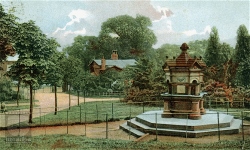 Land at Lowe Hill was given to the city and Clarence Park was opened in 1893. There are many attractions in this park including the Bandstand, Pavilion and matching shelters. There is also the lodge and the steep hill which provides seating when bands perform at the bandstand.
Land at Lowe Hill was given to the city and Clarence Park was opened in 1893. There are many attractions in this park including the Bandstand, Pavilion and matching shelters. There is also the lodge and the steep hill which provides seating when bands perform at the bandstand.
The Music Collective have worked very hard, in partnership with the Council, to reform the Bandstand to its former glory. They have repaired the roof, secured security surveillance and shutter doors and each year provided a schedule of performances.
See our Events and News page for concerts hosted by the Music Collective at the bandstand and other activities happening in the parks
History:
The idea of a public park in Wakefield to celebrate Queen Victoria’s Golden Jubilee was firstsuggested in 1887 and In 1890 Mr Charles Milne-Gaskell JP, who lived in Thornes House, offered land, including Lowe Hill and the surrounding agricultural land, to form a public park. Bought by public subscription and guided by a group of trustees the park began to take shape and on July 6 1893 the park was formally opened.

The Duke of Clarence had planted a white horse chestnut tree on the site of the proposed park and sycamores, chestnut and oak trees were planted, with a double row of 108 chestnuts lining the carriage drive in the park. Other features included a bandstand on Lowe Hill presented by Colonel Milnes-Gaskell planted round with three dozen oak trees and wrought iron gates at the entrance on Denby Dale Road provided by Lady Caroline Milnes-Gaskell. A decorative drinking fountain was erected in 1893 in the park as a memorial to Major Joseph Barker by the workforce of his worsted mill at Thornes Wharf.
A colour postcard depicting a scene from Wakefield Park in 1904. The drinking fountain can be seen in the foreground. It was erected in 1893, probably when Clarence Park was opened on the 6th July in memory of Major Barker of Holmfield House by the employees of his worsted mill at Thornes Wharf.
[Source: by kind permission of Wakefield Libraries and Museums, www twixtaireandcalder.org.uk]




















